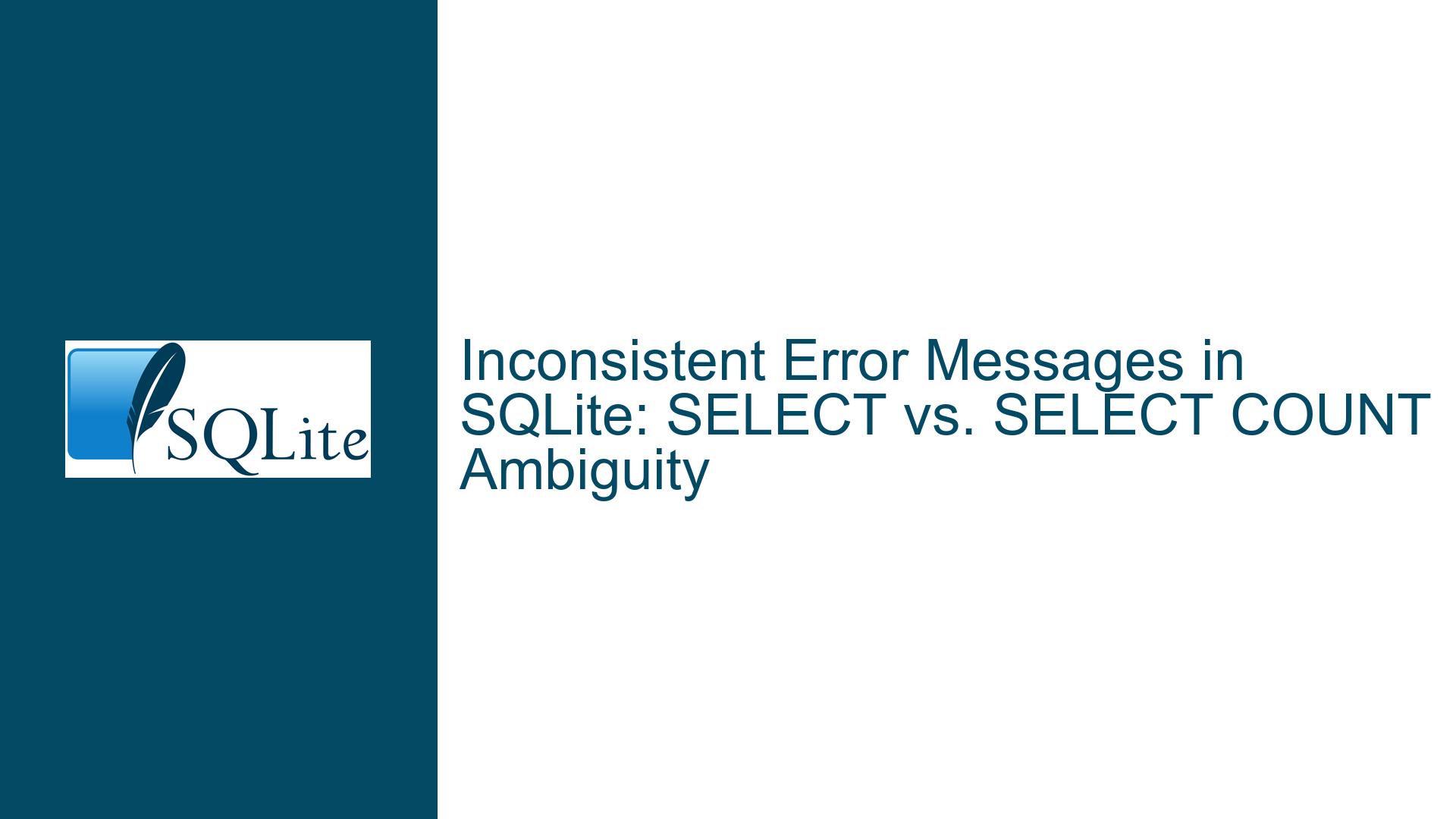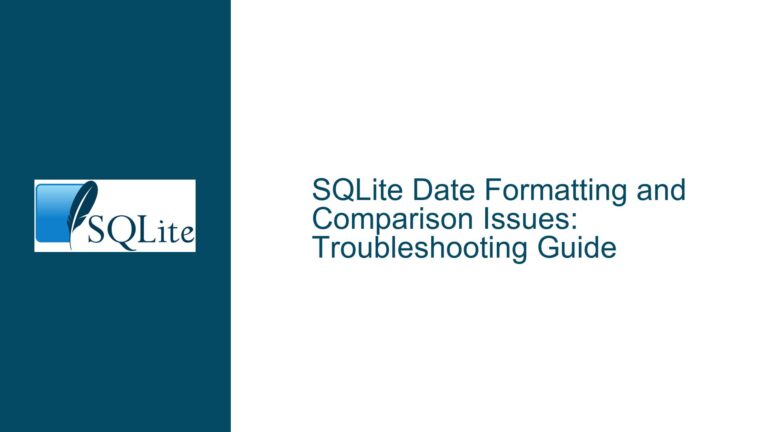Inconsistent Error Messages in SQLite: SELECT vs. SELECT COUNT Ambiguity
Ambiguous Column Name Error in SELECT vs. COUNT Behavior
The core issue revolves around the inconsistent behavior of SQLite when handling ambiguous column names in SELECT statements versus SELECT COUNT statements. Specifically, when joining a table with itself, a column reference that is ambiguous in a SELECT * query results in an error, while the same ambiguity in a SELECT COUNT(*) query does not trigger an error and instead returns a result (in this case, 0). This discrepancy raises questions about consistency in error handling and result generation across different types of SQL queries.
To understand this issue deeply, we must first examine the nature of ambiguous column references in SQLite. When a table is joined with itself, as in the example v0 JOIN v0, the column v1 exists in both instances of the table. In a SELECT * query, SQLite requires explicit disambiguation of column names to avoid confusion. However, in a SELECT COUNT(*) query, the ambiguity is seemingly ignored, and the query executes without error. This inconsistency can lead to confusion for developers who expect uniform behavior across all query types.
The behavior observed here is not necessarily a bug but rather a consequence of how SQLite parses and executes different types of queries. The SELECT * query attempts to resolve all column references, and when it encounters an ambiguous column name, it throws an error to prevent incorrect data retrieval. On the other hand, SELECT COUNT(*) is an aggregate query that does not rely on specific column values; it merely counts the number of rows that match the given conditions. Since the ambiguity does not affect the row count, SQLite allows the query to proceed.
This inconsistency, while explainable, can be problematic in scenarios where developers rely on uniform error handling. For example, if a developer writes a query that joins a table with itself and uses SELECT * during debugging, they might encounter an error due to ambiguous column names. If they later switch to SELECT COUNT(*) to check the number of matching rows, the absence of an error might lead them to believe that the query is correct, even though the underlying ambiguity remains unresolved.
Root Causes of Inconsistent Error Handling
The inconsistency in error messages between SELECT and SELECT COUNT statements can be attributed to several factors, including SQLite’s query parsing logic, the nature of aggregate functions, and the handling of ambiguous column references. Below, we explore these factors in detail.
SQLite’s Query Parsing Logic
SQLite’s parser processes SELECT and SELECT COUNT queries differently. In a SELECT * query, the parser must resolve all column references to construct the result set. When a column name is ambiguous (e.g., v1 in v0 JOIN v0), the parser cannot determine which instance of the column to use, leading to an error. This behavior is by design, as it prevents incorrect or unintended data retrieval.
In contrast, a SELECT COUNT(*) query does not require resolving individual column names. The COUNT(*) function operates at the row level, counting the number of rows that match the query’s conditions. Since the function does not depend on specific column values, the parser does not need to resolve ambiguous column names. As a result, the query executes without error, even if the column references are ambiguous.
Nature of Aggregate Functions
Aggregate functions like COUNT(*) are designed to operate on sets of rows rather than individual columns. When SQLite processes a SELECT COUNT(*) query, it focuses on the row count and ignores the specifics of column references. This design choice allows aggregate queries to execute efficiently, as they do not need to resolve column-level ambiguities.
However, this design also means that aggregate queries may overlook issues that would cause errors in non-aggregate queries. In the case of SELECT COUNT(*) FROM v0 JOIN v0 ON v1 = 0 WHERE 0, the ambiguity of v1 does not affect the row count, so the query proceeds without error. This behavior can be misleading, as it gives the impression that the query is free of issues, even though the underlying ambiguity remains.
Handling of Ambiguous Column References
SQLite’s handling of ambiguous column references is another factor contributing to the inconsistency. In a SELECT * query, the parser enforces strict rules to ensure that all column references are unambiguous. This enforcement is necessary to prevent incorrect data retrieval and to maintain the integrity of the result set.
In a SELECT COUNT(*) query, however, the parser adopts a more lenient approach. Since the query does not depend on specific column values, the parser allows ambiguous column references to pass without error. This leniency can be beneficial in some cases, as it allows aggregate queries to execute even when column references are ambiguous. However, it can also lead to confusion, as developers may not realize that their queries contain unresolved ambiguities.
Resolving Ambiguity and Ensuring Consistent Behavior
To address the inconsistency between SELECT and SELECT COUNT statements, developers can take several steps to resolve ambiguous column references and ensure consistent behavior across all query types. Below, we outline detailed troubleshooting steps and solutions.
Explicit Column Aliasing
One of the most effective ways to resolve ambiguous column references is to use explicit column aliasing. By assigning unique aliases to columns in self-joins, developers can eliminate ambiguity and ensure that their queries execute consistently across all contexts.
For example, consider the following modified query:
CREATE TABLE v0 ( v1 INT );
/* STMT 1 with aliasing */
SELECT a.v1 FROM v0 a JOIN v0 b ON a.v1 = b.v1 WHERE 0;
/* STMT 2 with aliasing */
SELECT COUNT(*) FROM v0 a JOIN v0 b ON a.v1 = b.v1 WHERE 0;
In this version, the columns v1 from the two instances of v0 are explicitly aliased as a.v1 and b.v1. This disambiguation ensures that both SELECT and SELECT COUNT queries execute without error, providing consistent behavior.
Using Table Aliases in JOIN Conditions
Another approach is to use table aliases in the JOIN conditions to clarify which instance of the table each column belongs to. This technique is particularly useful in self-joins, where the same table appears multiple times.
For example:
CREATE TABLE v0 ( v1 INT );
/* STMT 1 with table aliases in JOIN conditions */
SELECT * FROM v0 a JOIN v0 b ON a.v1 = 0 WHERE 0;
/* STMT 2 with table aliases in JOIN conditions */
SELECT COUNT(*) FROM v0 a JOIN v0 b ON a.v1 = 0 WHERE 0;
By specifying a.v1 in the JOIN condition, the query explicitly references the v1 column from the first instance of v0. This eliminates ambiguity and ensures consistent behavior across both query types.
Enforcing Strict Column Resolution
Developers can also enforce strict column resolution by using tools or linters that analyze SQL queries for ambiguous column references. These tools can identify potential issues before the queries are executed, helping developers maintain consistent behavior across all query types.
For example, SQLite’s EXPLAIN command can be used to analyze query execution plans and identify potential ambiguities. By reviewing the output of EXPLAIN, developers can spot unresolved column references and address them before running the queries.
Modifying Query Logic to Avoid Ambiguity
In some cases, modifying the query logic can help avoid ambiguity altogether. For example, instead of joining a table with itself, developers can use subqueries or common table expressions (CTEs) to achieve the same result without introducing ambiguity.
For example:
CREATE TABLE v0 ( v1 INT );
/* Using a subquery to avoid ambiguity */
SELECT * FROM (SELECT v1 FROM v0 WHERE 0) a JOIN (SELECT v1 FROM v0 WHERE 0) b ON a.v1 = b.v1;
/* Using a CTE to avoid ambiguity */
WITH a AS (SELECT v1 FROM v0 WHERE 0), b AS (SELECT v1 FROM v0 WHERE 0)
SELECT * FROM a JOIN b ON a.v1 = b.v1;
By breaking the query into smaller, unambiguous components, developers can avoid ambiguity and ensure consistent behavior across all query types.
Leveraging SQLite’s Error Handling Mechanisms
Finally, developers can leverage SQLite’s error handling mechanisms to detect and address ambiguous column references. For example, using TRY...CATCH blocks or similar constructs can help identify and handle errors related to ambiguous column names.
For example:
BEGIN TRY
SELECT * FROM v0 JOIN v0 ON v1 = 0 WHERE 0;
END TRY
BEGIN CATCH
PRINT 'Error: Ambiguous column name detected.';
END CATCH;
While SQLite does not natively support TRY...CATCH blocks, similar functionality can be achieved using procedural extensions or application-level error handling.
By understanding the root causes of inconsistent error handling and implementing the solutions outlined above, developers can ensure consistent behavior across SELECT and SELECT COUNT queries in SQLite. This approach not only resolves the immediate issue but also promotes best practices for writing clear, unambiguous SQL queries.






